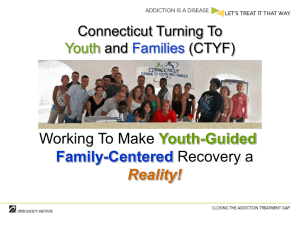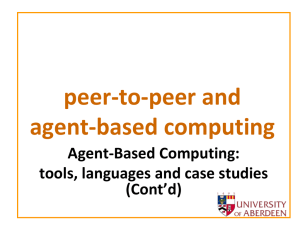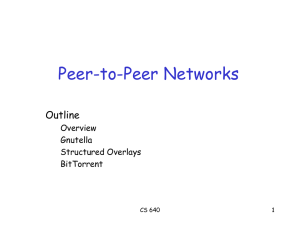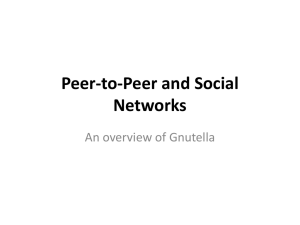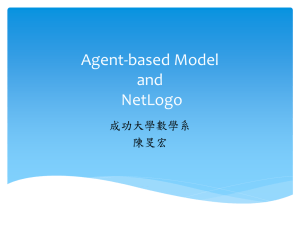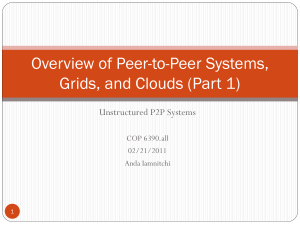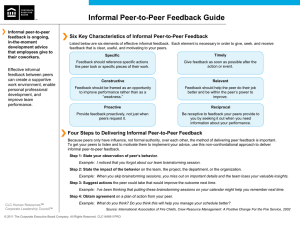PPT
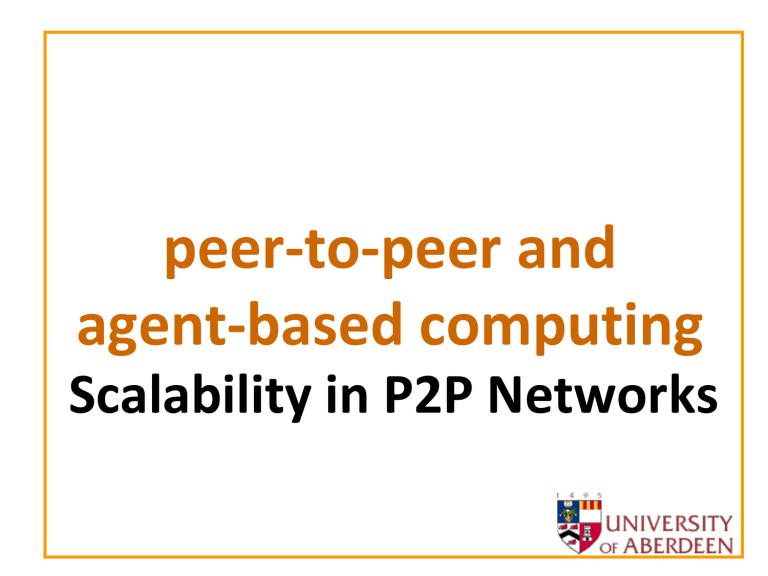
peer-to-peer and agent-based computing
Scalability in P2P Networks
Plan of lecture
• Optimising P2P Networks:
– Social networks and lessons learned
– Are P2P networks social?
– Organising P2P networks
• Peer Topologies
– Centralised, Ring, Hierarchical & Decentralized
– Hybrid:
• Centralised/Ring
• Centralised/Centralised
• Centralised/Decentralised
– Reflector Nodes
• Gnutella Case Studies peer-to-peer and agent-based computing – wamberto vasconcelos 2
Social networks
Stanley Milgram (Harvard professor ) – 1967 social networking experiment:
How many ‘hops’ would it take for messages to traverse US pop?
Omaha
Boston
• Posted 160 letters to randomly chosen people in Omaha, Nebraska
• Asked them to try to pass these letters to a stockbroker working in Boston,
Massachusetts
Rules:
1. use intermediaries they know on a first name basis, chosen intelligently!
2. make a note at each hop
• 42 letters made it !!
• Average of 5.5 hops
• Demonstrated the ‘small world effect’
Proved that the social network of the United States is indeed connected with a path-length (number of hops) of around 6 – the 6 degrees of separation!
Does this mean that it takes 6 hops to traverse 200 million people?
peer-to-peer and agent-based computing – wamberto vasconcelos
Lessons learned from experiment
• Social circles are highly clustered
• Few members have wide-ranging connections
– Form a bridge between far-flung social clusters
– Bridging plays critical role in bringing the network closer together
– For example:
• 25% of all letters passed through a local shopkeeper
• 50% mediated by just 3 people
• Lessons learned
– These people acted as gateways or hubs between the source and the wider world
– A small number of bridges dramatically reduces the number of hops peer-to-peer and agent-based computing – wamberto vasconcelos 4
From social to computer networks
• Similarities between social / computer networks
– People = peers
– Intermediaries = hubs, gateways
– Number of intermediaries = number of hops
• Are P2P networks special then?
– P2P networks more like social networks than other types of computer networks because:
• Self-organising
• Ad-Hoc
• Employ clustering techniques based on prior interactions
(like we form relationships)
• Decentralised discovery & communication
(similar to neighbourhoods, villages, etc) peer-to-peer and agent-based computing – wamberto vasconcelos 5
P2P: what’s the problem?
• How to organise peers in ad-hoc, multi-hop pervasive P2P networks?
– Network of self-organising peers organised in a decentralised fashion
– Networks may expand rapidly from few hundred to several thousand (or even millions) of peers peer-to-peer and agent-based computing – wamberto vasconcelos 6
P2P: what’s the problem? (Cont’d)
• P2P Environments:
– Unreliable
– Peers connect/disconnect – network failures
– Random failures (e.g. power outages, DSL failure)
– Personal machines more vulnerable than servers
– Algorithms must cope with continuous restructuring of the network core
• P2P systems
– Must treat failures as normal occurrences not freak exceptions
– Must be designed to promote redundancy
• Tradeoff with degradation of performance peer-to-peer and agent-based computing – wamberto vasconcelos 7
How do we organise P2P networks?
• Organisation aimed at optimum performance
• NOT abstract numerical benchmarks!!
– How many milliseconds will it take to compute this many millions of calculations?
• Rather, it means asking questions like:
– How long will it take to retrieve this particular file?
– How much bandwidth will this query consume?
– How many hops will it take for my package to get to a peer on the far side of the network?
– If I add/remove a peer to the network will the network still be fault tolerant?
– Does the network scale as we add more peers?
peer-to-peer and agent-based computing – wamberto vasconcelos 8
Performance issues in P2P networks
3 main features that make P2P networks more sensitive to performance issues
1. Communication
– Fundamental necessity
– Users connected via different connections speeds
– Multi-hop
2. Searching
– No central control so more effort needed
– Each hop adds to total bandwidth (w/ time outs!)
3. Equal Peers
– “Freeriders” – unbalance in harmony of network
– Degrades performance for others
– Need to get this right to adjust accordingly peer-to-peer and agent-based computing – wamberto vasconcelos 9
P2P topologies
Core
• Centralised
• Ring
• Hierarchical
• Decentralised
Hybrid
• Centralised-Ring
• Centralised-Centralised
• Centralised-Decentralised peer-to-peer and agent-based computing – wamberto vasconcelos 10
Centralised
• Client/server
• Web servers
• Databases
• Napster search
• Instant Messaging peer-to-peer and agent-based computing – wamberto vasconcelos 11
Ring
• Fail-over clusters
• Simple load balancing
• Assumption
– Single owner peer-to-peer and agent-based computing – wamberto vasconcelos 12
Hierarchical
• Tree structure
• DNS
• Usenet (sort of) peer-to-peer and agent-based computing – wamberto vasconcelos 13
Decentralised
• Gnutella
• Freenet
• Internet routing peer-to-peer and agent-based computing – wamberto vasconcelos 14
Centralised + Ring
• Robust web applications
• High availability of servers peer-to-peer and agent-based computing – wamberto vasconcelos 15
Centralised + Centralised
• N-tier apps
• Database heavy systems
• Web services gateways
• Google.com uses this topology to deliver their services peer-to-peer and agent-based computing – wamberto vasconcelos 16
Centralised + Decentralised
• New generation of P2P
• Clip2 Gnutella Reflector
• FastTrack
– KaZaA
– Morpheus
• Possibly like social networks?
peer-to-peer and agent-based computing – wamberto vasconcelos 17
Reflector nodes
• Known as ‘super peers’
– AKA “rendezvous peers” (JXTA)
• Cache file list of connected users
– Maintain an index
• When a query is issued, reflector node
– Does NOT retransmit it
– Answers the query using its own information
C F1.mp3
0
F1.mp3 –
ID0:F1.mp3
…
F2.mp3
1
F3.mp3
2 peer-to-peer and agent-based computing – wamberto vasconcelos 18
Napster = Gnutella?
Napster
Napster.com
User
N2
N3
Napster
User
=?
Gnutella
Napster
Duplicated
Servers
Gnutella Super Peers:
1. Natural??
2. Reflector peer-to-peer and agent-based computing – wamberto vasconcelos 19
Gnutella network today
• Topology of a Gnutella network
– From LimeWire site (popular Gnutella client)
• Notice power-law or centralised-decentralised structure peer-to-peer and agent-based computing – wamberto vasconcelos 20
Another view of Gnutella
peer-to-peer and agent-based computing – wamberto vasconcelos 21
Gnutella studies 1: “free riding”
Two types of free-riding:
1. Download files but never provide any files for others to download
2. Users that have undesirable content peer-to-peer and agent-based computing – wamberto vasconcelos 22
Gnutella studies 1: “free riding”
(Cont’d)
• Article: “Free Riding on Gnutella”, E. Adar and B.A.
Huberman (2000):
– 22,084 of the 33,335 peers in the network (66%) of the peers share no files
– 24,347 or 73% share ten or fewer files
– Top 1% (333 hosts) represent 37% of total files shared
– 20% (6,667 hosts) sharing 98% of files
• Findings:
– Even without Gnutella reflector nodes , the Gnutella network naturally converges into a centralised + decentralised topology with the top 20% of nodes acting as super peers peer-to-peer and agent-based computing – wamberto vasconcelos 23
Gnutella studies 2: equal peers
• Studied Gnutella for one month
– Noted an apparent scalability barrier when query rates went above 10 per second
• Why?
– Gnutella query: 560 bits long
• Queries make up approximately ¼ of traffic
– Each peer is connect to three peers:
• 560 × 10 × 3 = 16,800 bytes/sec
• ¼ of traffic, so total traffic 67,200 bytes/sec
– 56-K link cannot keep up with amount of traffic
• One node connected in the incorrect place can grind the whole network to a halt
– This is why P2P networks place slower nodes at the edges peer-to-peer and agent-based computing – wamberto vasconcelos 24
Gnutella studies 3: communication
• Article: Peer-to-Peer Architecture Case Study:
Gnutella Network, Matei Ripeanu
– Studied topology of Gnutella over several months
• Two important findings
• Two suggestions peer-to-peer and agent-based computing – wamberto vasconcelos 25
Gnutella studies 3: communication
Findings:
1. Gnutella network shares the benefits and drawbacks of a power-law structure
– Networks that organise themselves so that most nodes have few links & small number of nodes have many links
– Unexpected degree of robustness when facing random node failures.
– Vulnerable to attacks: removing a few super nodes can have massive effect on function of network as a whole.
2. Gnutella network topology does not match well with underlying Internet topology
– Leads to inefficient use of network bandwidth peer-to-peer and agent-based computing – wamberto vasconcelos 26
Gnutella studies 3: communication
Suggestions:
1. Use a software agent to monitor network and intervene by asking servents to drop/add links to keep the topology optimal.
2. Replace Gnutella flooding mechanism with a smarter routing and group communication mechanism peer-to-peer and agent-based computing – wamberto vasconcelos 27
What about other topologies?
• Centralised + Hierarchical?
– Back end tree of information
– Caching architectures
• Decentralised + Ring?
– P2P network of fail-over clusters
• What else?
peer-to-peer and agent-based computing – wamberto vasconcelos 28
Further reading
• Chapter of textbook
• Free Riding on Gnutella, E. Adar and B.A.
Huberman (2000), First Monday 5(10) http://firstmonday.org/htbin/cgiwrap/bin/ojs/index.php/fm/article/view/792
• Peer-to-Peer Architecture Case Study: Gnutella
Network, Matei Ripeanu http://www.cs.uchicago.edu/files/tr_authentic/TR-2001-26.pdf
• Distributed Hash table models
– Pastry: http://research.microsoft.com/~antr/pastry
– Chord: http://en.wikipedia.org/wiki/Chord_(peer-to-peer) peer-to-peer and agent-based computing – wamberto vasconcelos 29
